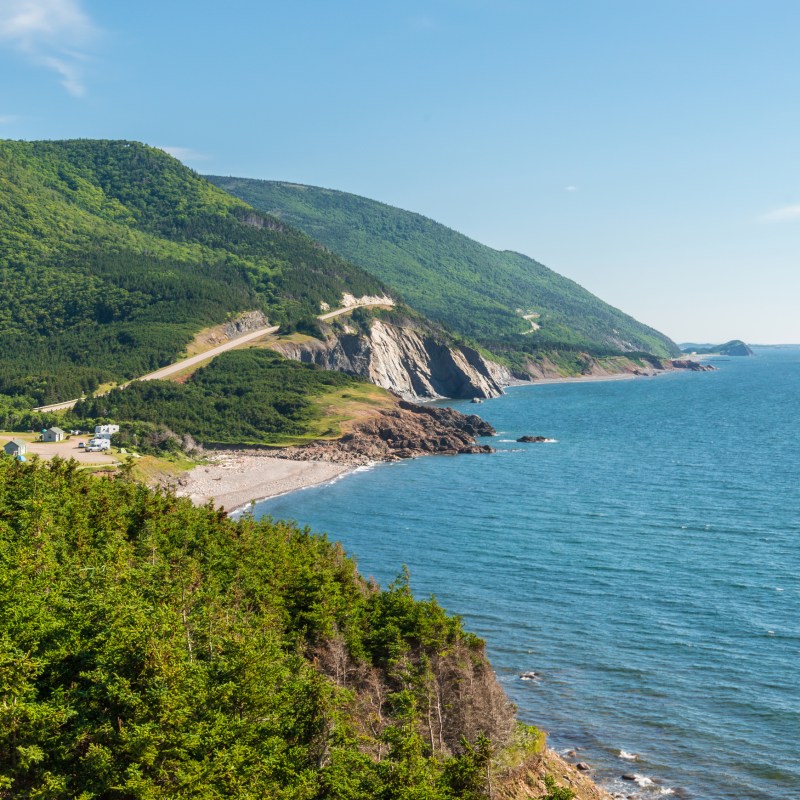
On the northern tip of Nova Scotia sits an island that locals describe as a little slice of heaven. A mix of oceans, mountains, lakes, and rolling highlands, Cape Breton Island is also a mix of cultures. It is home to people of Scottish, British, Irish, Acadian, and Mi’kmaq heritage and is one of the largest Gaelic-speaking regions in the world. On a visit, you’ll see and hear the Gaelic words cead mile failte — “one hundred thousand welcomes” — everywhere, whether the community you’re exploring is Scottish or not!
Videos by TravelAwaits
These are some of the activities and attractions that make Cape Breton Island such a memorable and welcoming destination.
1. Church And Community Dinners
From turkey dinner platters to pancake breakfasts, the best food on Cape Breton Island is served at church and community dinners. In some villages, this is a regular occurrence that happens once a month or so for an ongoing fundraiser. You’ll also see these special dinners during festivals and holidays (many organizations host a Thanksgiving and Easter turkey or ham dinner each year), as well as when money is needed for a good cause.
Visitors are always welcome. You can expect large portions, sides like rolls and pickles (like Nova Scotia’s beloved chow chow), dessert, and coffee and tea. These dinners are always affordable — $10 to $20 is standard — and you’ll almost always pay in cash. Occasionally, there will be a choice of main courses, but vegetarian options aren’t common.
You can learn about upcoming dinners by checking the bulletin boards at supermarkets, gas stations, and tourist information centers, as well as in church bulletins and on social media.
2. Ceilidhs And Concerts
Cape Breton Island is one of the best destinations in the world for traditional Scottish-Gaelic music and dance. Across the island, you will find ceilidhs (pronounced KAY-lees), or concert events that happen at church or community halls. You can expect lively, Scottish-influenced performances (though other cultures are often represented) featuring Gaelic singing, fiddle music, storytelling, and step-dancing. Admission costs range from free to $10, and the events often include a tea, or midevening break for coffee, tea, finger sandwiches, biscuits, and sweets.
Every autumn, the Celtic Colours International Festival takes place at venues across Cape Breton Island. Ranging from intimate, informal events to larger concerts with internationally recognized artists that require tickets purchased in advance, it’s one of the largest celebrations of Celtic music and culture in the world.

3. The Cabot Trail
The 185-mile long Cabot Trail is one of the most beautiful drives in Canada — though locals will say that it’s the most spectacular drive in the world! It’s certainly the top attraction on Cape Breton Island, so visitors should set aside a day to complete the drive. There are multiple small communities to stop and visit along the way, and craft shops, little museums, and scenic side diversions are common. On the main drive itself, you can expect dramatic ocean views, valleys and forests, and lush, green highlands.

4. Cape Breton Highlands National Park
A significant part of the Cabot Trail goes through Cape Breton Highlands National Park, home to some of the best hiking and wildlife viewing in Nova Scotia. Be sure to make time for the park’s Skyline Trail. This 4-mile return hike is rated as suitable for beginners and is home to the most sensational views in the entire park. Hikers will enjoy unobstructed views of rolling hills, the ocean, and rare plant life. Eagles, moose, and bears are frequently spotted as well. However, there is one kind of wildlife that is not welcome — mosquitoes and other flies hang out all summer, and guests will be happy they brought along bug spray.
If you enjoy seeing wildlife in a little less wild of an environment, the Whale Interpretive Centre in Pleasant Bay presents the story of the area’s whales and marine animals. The area is also a gateway to Cheticamp, one of Nova Scotia’s most important Acadian villages and an excellent spot for whale-watching tours.

5. Fortress Of Louisbourg National Historic Site
If you were a French or British soldier in the mid-1700s, chances are the Fortress of Louisbourg would have been on your mind. Situated at one of the most unforgiving, weatherbeaten spots in North America, this fort on western Cape Breton was designed to defend French interests from the British — and then, after some skirmishes, it changed hands, and the British used it to defend their interests from the French. Everyday life for the soldiers stationed there was grim. You did not want to be assigned to this extremely isolated, gray, damp fortress!
Thankfully, the modern-day Fortress of Louisbourg is anything but grim for the thousands of guests who visit each year. Since the 1960s, portions of the Fortress of Louisbourg have been carefully restored, using much of the original stone from the 1700s, and excavations are ongoing. In fact, Louisbourg is the largest restoration project in North America. It’s also a spectacular living history museum, and visitors can see how villagers, soldiers, and officers lived during different eras. A highlight of any visit is lunch in the mess hall, where diners can only use large pewter spoons to eat, much like the lowly footsoldiers of old. Be sure to order the delicious bread pudding! Another great spot is the reconstructed bakery, where soldiers would receive their ration of bread. Heavy, old-fashioned loaves and soft, modern bread are for sale.
One thing that hasn’t changed in nearly 300 years is the weather at the Fortress of Louisbourg. The site is still cold, damp, and blustery when the rest of Cape Breton is sunny. Dress in light layers and bring a raincoat or poncho.
6. Miners Museum
Cape Breton Island’s leading industries — fishing, forestry, and mining — are strongly linked to its arts and culture scene and crop up regularly in the region’s writing, music, and folklore. Nowhere is this more evident than at the Glace Bay’s Miners Museum. For decades, coal mining was a crucial part of the identity of all of Glace Bay. While the industry was strong, working conditions were harsh, and the power of the company was absolute. The miners and their families found strength in music, a tradition that continues to this day, though there is little active mining at present. Visitors can learn more by taking a tour of a mine or enjoying a concert by The Men of the Deeps choir of working and retired miners.

7. Membertou Heritage Park
The Mi’kmaq people of Membertou and their ancestors have lived in the area since time immemorial. At the Membertou Heritage Park, a 5-acre site that serves as a living history of the people of Membertou, a large indoor exhibit offers a full introduction to the first people of this region. The on-site Petroglyphs Gift Shop specializes in aboriginal arts and crafts from across Canada.
Nearby Kiju’s Restaurant offers a traditional Mi’kmaq-inspired menu (popular ingredients include pheasant, duck, salmon, bison, berries, and maple) and a Canadian-fusion menu with ample vegetarian and gluten-free selections. Delicious choices include sesame-crusted halibut, butternut squash ravioli, fish cakes and beans, and curried apple quinoa salad.
8. Alexander Graham Bell National Historic Site
Cape Bretoners are well known for their love for chit-chat, so it seems particularly fitting that the life of Alexander Graham Bell, inventor of the telephone and pioneer of education for the deaf, is celebrated on Cape Breton Island.
Bell arrived in the town of Baddeck after he invented the telephone and found financial success. During his time there, he turned his scientific efforts to sound transmission, medicine, aeronautics, marine engineering, and space-frame construction. Visitors to the Alexander Graham Bell National Historic Site established in his honor can see the world’s largest collection of mementos, photos, and models from Bell’s life, including his personal notebooks and walking stick.
There are multiple tours and special experiences, including a tour that introduces visitors to the most precious parts of the collection plus provides an introduction to conservation techniques. There is also a full-scale replica of the famous Silver Dart aircraft and a model HD-4 Hydrofoil craft, plus ample programming for children.
9. Christmas Island Post Office
The tiny village of Christmas Island is home to a few inhabitants, a fire hall (which often hosts Gaelic culture events), and a diminutive post office. Every autumn, this wee building becomes one of the busiest post offices in the world thanks to its fanciful, holiday-themed postmark. If you love celebrating Christmas, pop in, say hello, and inquire how you can send them your holiday mail for stamping.

10. The Beaches
Beaches dot the coastline of Cape Breton Island. Most are part of either provincial or municipal parks and usually offer basic changing rooms and washroom facilities, picnic tables, and parking lots. Some popular Cape Breton beaches to explore include West Mabou Beach (the nearby Red Shoe Pub in Mabou is a popular place for food, drinks, and music), Dominion Beach Provincial Park (the Miners Museum is close by), and Point Michaud Beach Provincial Park (which is home to good surfing).
